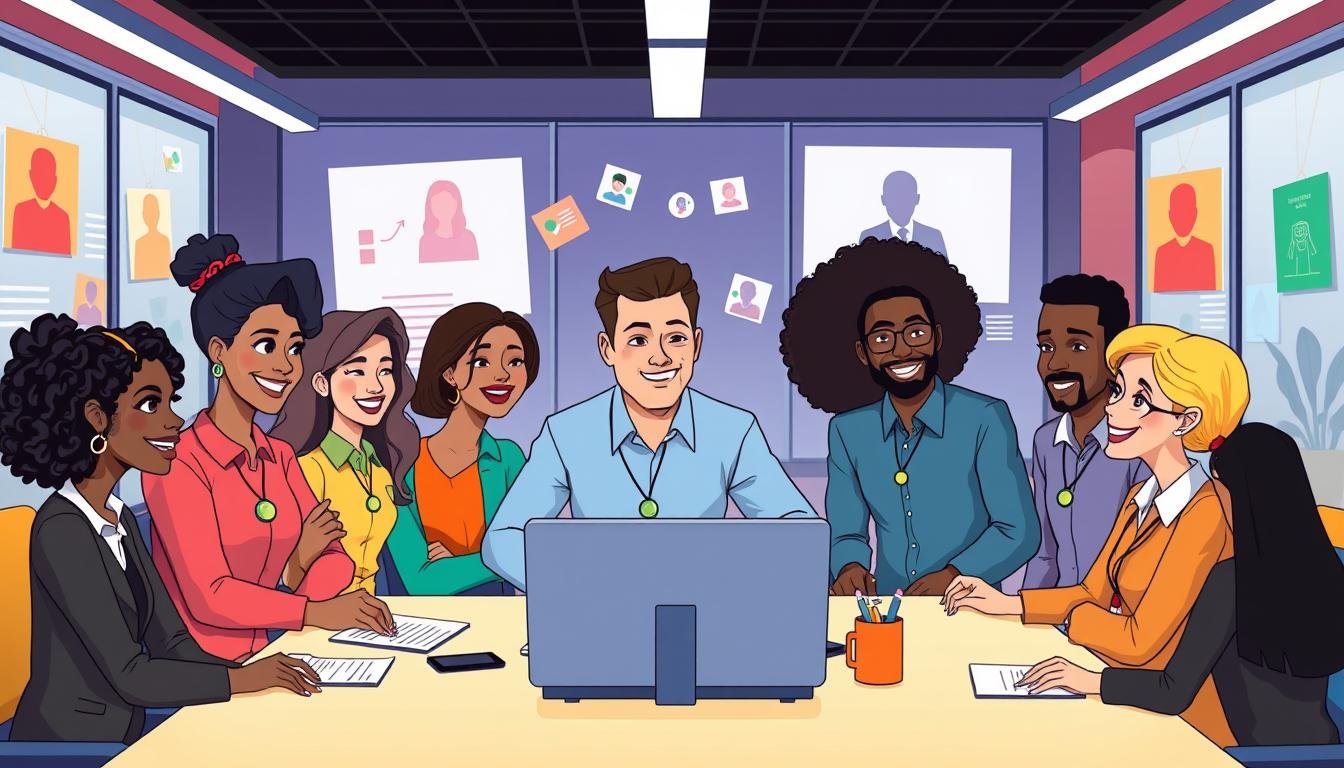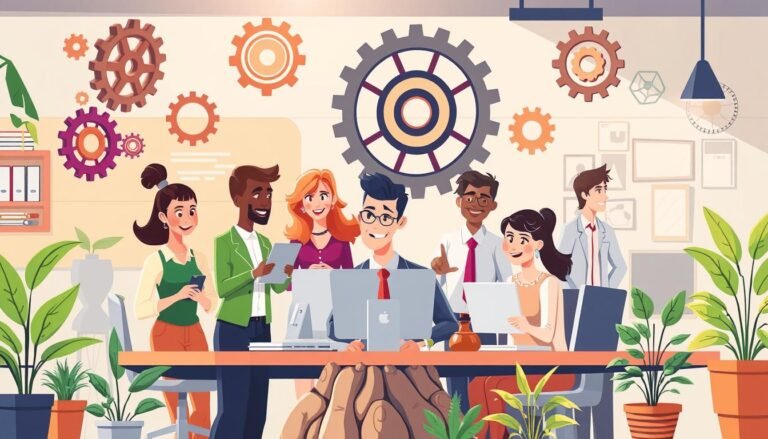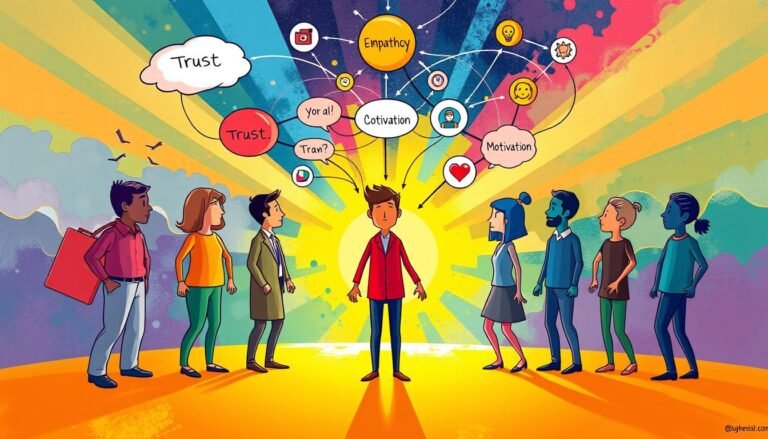Social Identity Theory in the Workplace: What Leaders Need to Know
Ever wondered why some teams click right away while others struggle? Social Identity Theory (SIT) might hold the key. It reveals the complex world of workplace dynamics and offers insights for leaders in various settings.
SIT shows how we group ourselves and others, shaping our identity and actions. In work, it’s key to team harmony, conflict, and culture. Leaders who understand SIT can better navigate today’s workplaces.
SIT helps us see why some employees bond more with their team than the company. It also explains why some groups might fight. By using SIT, leaders can create a more welcoming space, boost teamwork, and achieve success.
Key Takeaways:
- SIT explains group dynamics and intergroup relations in organizations
- Understanding SIT can help leaders navigate workplace challenges
- Social categorization impacts team dynamics and collaboration
- In-group favoritism can influence workplace politics
- SIT principles can be applied to foster inclusivity and improve performance
Understanding Social Identity Theory
Social Identity Theory (SIT) is key in shaping how we work together and the culture of our workplaces. It was created by Henri Tajfel and John Turner in the 1970s. It shows how we sort ourselves and others into groups.
Definition and Core Concepts
SIT looks at three main areas: how we categorize, identify with, and compare ourselves to others. These actions shape how we act towards different groups. We often see ourselves through our group memberships, not just our personal traits.
Origins and Key Theorists
Tajfel and Turner started it all with their minimal-group studies in the early 1970s. They found that even random group assignments could lead to favoring one’s own group. This led to more research into how groups form and how we identify ourselves.
Importance in Organizational Contexts
In the workplace, SIT helps us understand team dynamics, rivalries between departments, and how employees act. Knowing these concepts can help solve conflicts and improve the workplace culture. Leaders who understand SIT can create a more welcoming place and manage group relations well.
| SIT Component | Workplace Impact |
|---|---|
| Social Categorization | Team formation, departmental divisions |
| In-group Favoritism | Collaboration challenges, potential bias |
| Social Comparison | Competitive behavior, status-seeking |
The Role of Social Categorization in the Workplace
Social categorization is key in the workplace. Employees sort themselves and others by many factors. These include job roles, department, and hierarchy. This helps them understand their work place and social structures.
Studies show it affects how employees act and feel. A study in Group Processes & Intergroup Relations found social identity theory’s impact grew in the 1990s. It explains how employees form and keep their workplace identities.
Knowing about social categorization helps leaders see where collaboration or conflict might happen. For example, departments or job roles can create in-groups. These can have both good and bad effects.
| Categorization Factor | Potential Impact |
|---|---|
| Employee Classification | Influences job satisfaction and commitment |
| Departmental Affiliation | Affects team dynamics and collaboration |
| Job Roles | Shapes individual and group identities |
| Organizational Hierarchy | Impacts communication and decision-making processes |
By understanding these categories, leaders can work on a shared identity. This respects individual differences. It can boost engagement, teamwork, and performance.
In-Group Favoritism and Out-Group Bias
Workplace dynamics often show subtle group preferences that shape team cohesion. In-group favoritism and out-group bias are strong forces that affect how employees work together. These biases can cause workplace discrimination if not managed.
Manifestations in Organizational Settings
In offices, in-group favoritism might show as favoring team members or departmental colleagues. This can mean unfair sharing of resources or promotions. Out-group bias might show as not inviting certain employees to important meetings or social events, blocking their growth.
Impact on Team Dynamics and Collaboration
These biases greatly impact team dynamics. Studies show in-group favoritism happens in 60% to 90% of cooperative situations. This preference can create invisible barriers, reducing teamwork and productivity. Feeling left out can hurt team cohesion and job satisfaction.
Strategies for Mitigating Biases
Leaders are key in fighting biases. Starting with diversity and inclusion initiatives is a good step. Cross-departmental projects can help break down barriers. Team-building exercises that mix different groups can also help.
Training on unconscious bias awareness is also effective. By tackling these issues, organizations can improve teamwork and create a more welcoming culture.
“The key to overcoming in-group favoritism is creating opportunities for meaningful interactions across different groups within the organization.”
Self-Categorization and Employee Behavior
Self-categorization is key in shaping who we are at work. It’s based on Social Categorization Theory. This theory shows how we see ourselves as part of a group and follow its rules. At work, we often see ourselves as part of a team or department.
This way of seeing ourselves affects how we act at work. When we strongly identify with a group, we act like them. This can make our team work better together. But it might make working with other teams harder.
Leaders can use this knowledge to make work better. By understanding our group identities, managers can work better with us. This can make our team work better and our company culture stronger.
| Level of Self-Categorization | Description | Impact on Workplace Behavior |
|---|---|---|
| Personal Self | Individual identity and unique traits | Influences personal work style and preferences |
| Social Self | Group memberships and roles | Shapes interactions with colleagues and team dynamics |
| Human Identity | Shared human characteristics | Affects broader organizational values and ethics |
Knowing about these levels of self-categorization helps leaders create a welcoming place. It respects our differences but also brings us together. This way, companies can use everyone’s ideas while staying as one team.
Social Identity Theory and Leadership
Leadership styles are key in shaping a company’s identity and boosting employee engagement. Social Identity Theory helps leaders build a unified workplace culture while valuing individual differences.
Identity-based Leadership Approaches
Good leaders understand the power of social identities at work. They match their leadership style with their team’s identities to improve engagement and performance. Studies show that feeling part of the organization boosts job satisfaction and performance.
Fostering a Shared Organizational Identity
Building a strong organizational identity is vital for a unified team. Leaders who share a vision and values can greatly influence employee attitudes and actions. Research shows that feeling part of the organization is linked to stronger commitment and extra effort.
Balancing Individual and Group Identities
Inclusive leadership means valuing diverse identities in the workplace. Leaders who balance individuality with teamwork create an environment where everyone feels unique yet connected. This approach reduces stress and boosts team support.
| Aspect | Correlation with Organizational Identification |
|---|---|
| Affective Organizational Commitment | ~0.53 |
| Job Satisfaction | ~0.37 |
| Job Involvement | ~0.41 |
| Turnover Intentions | ~ -0.48 |
| In-role Performance | ~0.22 |
Intergroup Relations and Conflict Management
Workplace conflicts often come from group dynamics based on social identities. A study by Hogg and Williams (2000) shows how social identity changes from “I” to “We.” This change can lead to both good and bad outcomes in work settings.
It’s key to understand these dynamics for solving conflicts. Research by Cooper and Fazio (1986) explains how attitudes supporting group conflicts form and stay. Leaders can use this to tackle underlying issues and build better group relations.
Brewer and Gardner’s 1996 study gives insights into how people see themselves in relation to group identities. Knowing this is crucial for managing workplace conflicts and boosting team work. By seeing these social identity layers, leaders can create plans that meet both individual and group needs.
“Effective conflict management techniques based on Social Identity Theory principles can improve collaboration and reduce workplace tensions.”
To help group relations, leaders should:
- Find out what causes tension between groups
- Build a shared work identity
- Encourage working together across groups
- Deal with biases based on identity
By using these methods, companies can turn group dynamics from conflict sources into drivers of innovation and productivity.
| Conflict Source | SIT-Based Resolution Strategy |
|---|---|
| In-group favoritism | Promote shared superordinate goals |
| Status differences | Emphasize complementary strengths |
| Resource competition | Implement collaborative projects |
| Cultural misunderstandings | Facilitate intercultural dialogues |
Diversity, Inclusion, and Social Identity
Workplace diversity is more than just numbers. It’s about valuing different social identities and using them to innovate. Companies that welcome diverse views often become more creative and solve problems better.
Leveraging Diverse Identities for Innovation
Organizations can use the unique experiences of employees from different backgrounds. This diversity of thought brings new ideas and ways to tackle challenges. For instance, a team with members from various cultures might create products that appeal to more people worldwide.
Creating an Inclusive Workplace Culture
Inclusive practices help everyone feel like they belong. This means recognizing and respecting different social identities, like race, gender, sexual orientation, and religion. When people feel valued, they tend to do their best work.
Addressing Identity-Based Discrimination
Leaders must fight discrimination to ensure a fair workplace. This involves strong anti-discrimination policies and regular training. It’s important to tackle both obvious and subtle biases that can affect employee well-being and performance.
| Benefits of Diversity & Inclusion | Implementation Strategies |
|---|---|
| Increased innovation | Diverse hiring practices |
| Better problem-solving | Inclusive leadership training |
| Improved employee satisfaction | Regular diversity workshops |
| Enhanced company reputation | Clear anti-discrimination policies |
By embracing diversity and inclusion, companies can create a workplace where everyone thrives. This approach benefits both individuals and the business. It leads to more innovation and adaptability in today’s diverse global market.
Social Identity Threat and Performance
Social identity threat greatly impacts how well employees do their jobs and how stressed they feel at work. It happens when people worry about being judged by negative stereotypes about their group. This worry can really hurt how well they work and how happy they are.
Studies show that many groups face this threat, like racial or ethnic minorities and LGBTQ+ people. It comes in three ways: stereotype threat, prejudice threat, and discrimination threat. These can make people solve problems worse, feel more anxious, and want to do less.
Leaders can fight this threat by affirming people’s identities. A supportive work place that fights stereotypes and values diversity can make employees do better. Also, teaching workers to be resilient can help them deal with stress from identity issues.
| Effects of Social Identity Threat | Mitigation Strategies |
|---|---|
| Decreased test scores | Create supportive environment |
| Increased anxiety and stress | Challenge negative stereotypes |
| Reduced motivation | Develop resilience strategies |
| Avoidance behaviors | Promote diversity and inclusion |
By tackling social identity threat, companies can make their workplaces more welcoming. This improves how well employees do and makes them less stressed. It’s good for both the workers and the company’s success.
Organizational Change Through the Lens of Social Identity Theory
Social Identity Theory (SIT) gives us a new way to look at organizational change. It’s especially useful in today’s fast-changing business world. Mergers, acquisitions, and restructuring happen all the time.
Identity Transitions During Mergers and Acquisitions
When companies merge or are acquired, employees’ social identities can change. These shifts affect how people see themselves in the new company. Studies show that good change management tackles these identity issues. It helps people feel connected and part of the team.
Restructuring and Employee Identities
When a company restructures, it can change how employees see themselves. Roles and teams might change, making it hard for people to keep their sense of self. Leaders who get this can help employees adjust. This keeps everyone productive and engaged during the change.
Change Management Strategies Informed by SIT
Good change management based on Social Identity Theory includes:
- Sharing a clear vision for the company
- Keeping a sense of continuity between old and new identities
- Encouraging teamwork to build new connections
- Supporting employees through identity changes
By using these methods, leaders can help their companies change smoothly. This keeps the team’s sense of identity strong.
Practical Applications of Social Identity Theory for Leaders
Leaders can use Social Identity Theory (SIT) to improve team building and culture. They can understand how employees see themselves in different groups. This helps leaders create strategies that bring teams together.
One way to apply SIT is through team-building activities. These activities help team members feel connected and supported. When people feel they belong, they work better and help the team succeed.
Leaders can also use SIT to make policies that respect everyone’s identity. This makes the workplace better for all employees. It creates a place where everyone feels valued and respected.
Using SIT, managers can tackle issues like favoritism and bias. They can build bridges between different groups. This leads to better teamwork and a more productive workplace.
Source Links
- Workplace Politics: A Social Identity Theory Perspective
- Your full self: Social identities and the workplace
- Social identity theory | Definition, History, Examples, & Facts
- Social Identity Theory In Psychology (Tajfel & Turner, 1979)
- Understanding Social Identity Theory and Its Impact on Behavior
- Frontiers | Scrutinizing Social Identity Theory in Corporate Social Responsibility: An Experimental Investigation
- Social identity: The role of self in group processes and intergroup relations
- In-group favoritism
- In-group favouritism and out-group discrimination in naturally occurring groups
- Preferences and beliefs in ingroup favoritism
- Self-categorization theory
- Self-Categorization Theory
- Microsoft Word – FBR-2016-3-1.doc
- Social identity theory and leader–member exchange: individual, dyadic and situational factors affecting the relationship between leader–member exchange and job performance
- Social Identity Theory
- Social Identity and Intergroup Competition
- Social Identity Theory: Overview | SAFS Diversity, Equity, and Inclusion Blog
- Diversity, Social Identities, and a Welcoming Environment | Inclusive Teaching | Teaching Guides | Teaching Commons
- Understanding The Social Identity Threat
- Social Identity Theory: I, You, Us & We. Why Groups Matter
- Social identity theory
- Social Change Research and the Social Identity Theory
- 90695 166..180
- Silos and Social Identity: The Social Identity Approach as a Framework for Understanding and Overcoming Divisions in Health Care
- (Social) Identity Theory in an Era of Identity Politics: Theory and Practice | Published in AIB Insights







